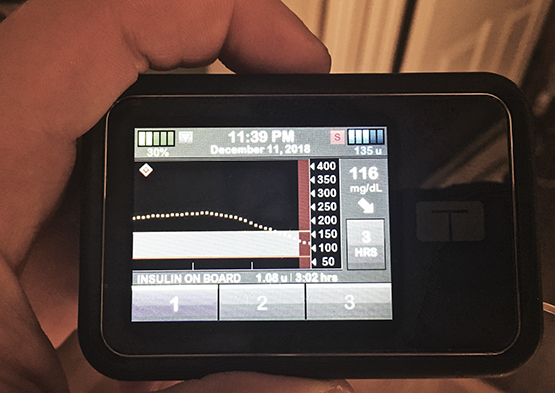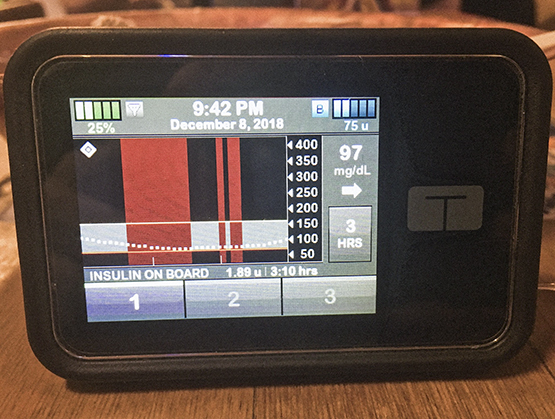As you may know, the FDA approved Basal-IQ® technology from Tandem Diabetes Care® in June 2018, and the software update for the t:slim X2™ insulin pump was made available to in-warranty t:slim X2 pump users a month later.
The premise? The algorithm uses data from a continuous glucose monitor (CGM) and predicts impending low blood sugar thirty minutes out. If it predicts a future low, the pump suspends insulin delivery to prevent hypoglycemia. Research demonstrated
it resulted in a 31% reduction in time below 70 mg/dL relative to a pump and CGM system without Basal-IQ technology.1
The technology was approved for use in children as young as 6 years old. Six! And 91% of clinical study participants said the Basal-IQ feature on the t:slim X2 insulin pump was easy to use.1
That all sounded pretty great to me, so I had to try it out for myself, see what all the hype was about, and see if it lived up to expectations.
Basal-IQ technology requires integration with the Dexcom G6® CGM, and I’ve been rocking a Dexcom G5® Mobile CGM for a long, long time. It took me a while to get access to a Dexcom G6 transmitter, but I did, so I could finally experience the system.
It’s time to walk you through the experience.
Anyone who wishes to make the leap to Basal-IQ technology must undergo some basic training, so they are comfortable and familiar with the system.
The training is a series of videos that describe what the system is, how it works, and how to use the pump with the system enabled. General pump training is important because you can choose to use the pump without CGM or Basal-IQ technology activated, use it just to have your CGM integrated, to see your data on your pump, or with both CGM and Basal-IQ technology. There are some quizzes at the end of each video, but you can repeat them multiple times if you don’t pass.
Of course, I passed each one on the first try. *insert angel emoji here*
Total time spent learning: ~1 hour
Then, the fun part: the update itself.
Actual time to update the pump: roughly 10 minutes.
Total time spent updating knowledge and pump: 70 minutes.
Not too shabby for the newest technology, but still a chunk of time you need to set aside.
Testing out Basal-IQ technology
The first day, I felt my pump vibrate - I’d activated the optional suspend and resume alerts after doing the training. Since it was my first time, I opted to keep these alerts on in order to learn as much as I could about all of the feature's activities.
And, the Out of Range alert would let me know of potential situations where Basal-IQ technology wouldn't suspend, like if connectivity to my CGM was lost. When I looked at my pump, I had a message on the screen saying insulin was suspended because
the algorithm predicted my blood sugar could go low in the next 30 minutes.
I was 125 with a partial down arrow.
“This seems excessive,” I thought to myself. “I’m not low, and who’s to say I will be low later on?”
But my insulin resumed shortly after and my blood sugar stabilized at 95 mg/dL.
An hour after that, I was still sitting between 90 mg/dL and 97 mg/dL.

Without further ado, here are my main takeaways from this experience:
Top Four Takeaways:
- The prevention of nighttime lows was HUGE.
You may or may not experience a similar situation, but typically my blood sugar drops at nighttime while I’m asleep.
This could be due to the large amount of physical activity earlier in the day, or due to an over correction at night, or a million other possible reasons.
Some days, it settles around 80-90 mg/dL, and other days, it becomes a legitimate low.
Basal-IQ technology was able to prevent lows almost every single time.
Did the vibrations occasionally wake me up? Yes. (Remember I kept optional alerts on overnight so that I would know if my CGM connectivity was affecting Basal-IQ technology.)
Was it 100% worth it? Yes.
The alternative would be crashing, correcting, possibly overcorrecting, and then ending up with a higher blood sugar that could take a while to come down.
- Hyperglycemia concerns eased.
I often set temp basal rates prior to exercise, and occasionally I see a high blood sugar later, maybe the temp rate was off, or my insulin needs were higher than expected during the workout. I worried about this using Basal-IQ technology.
Hyperglycemia only happened to me three times while using the feature. There were a few instances where Basal-IQ technology suspended for 30-60 minutes, and I was a higher after. But, it was only a few times out of a possible 28 automated suspensions. And if I’d been low and eaten, I might have been even higher later than I was after the suspension.

- Bonus: I needed fewer calories to avoid and treat lows.
I’m a registered dietitian, so I think about food about 90% of the day. I also tend to treat lows rather conservatively. I will eat three glucose tabs and wait rather than ravage the fridge. However, with Basal-IQ technology reducing the
incidence of hypoglycemic episodes, I was ingesting even fewer calories to correct these lows.
I’m on a well-designed nutrition plan and these calories add up. It’s annoying to have to add low snacks to my overall meal plan … and ultimately take away from other delicious foods I’d rather be eating.
For someone that overeats for lows, this could save hundreds of calories per week …
- It’s stupid easy to use.
Once it is set up and activated, you legitimately don’t need to touch the pump to keep the algorithm working for you in the background. The system takes care of itself, provided your Dexcom G6 CGM is working properly and can communicate with your
pump.
Basal-IQ technology is an absolute GAMECHANGER for anyone on a t:slim X2 insulin pump willing to use CGM.
Responsible Use of Basal-IQ Technology
Basal-IQ technology is not a substitute for active diabetes management and does not prevent hypoglycemia in all scenarios. Basal-IQ technology will not be able to predict glucose levels and suspend insulin delivery if your CGM is not working properly or is unable to communicate with your pump. Always pay attention to your symptoms and blood glucose levels and treat according to your healthcare provider’s recommendations.
1Forlenza GP, Li Z, Buckingham BA, Pinsker JE, et al. Predictive low-glucose suspend reduces hypoglycemia in adults, adolescents, and children with type 1 diabetes in an at-home randomized crossover study: Results of the PROLOG trial. Diabetes Care. 2018;41(10):2155-2161.doi:10.2337/dc18-0771.
Author Bio: Ben Tzeel has lived with type 1 diabetes since 1999. He has a master’s degree in nutrition from the University of North Carolina at Chapel Hill and is a registered dietitian. He is a Certified Strength and Conditioning Specialist (CSCS)
through the National Strength and Conditioning Association, is a published fitness model, and writes about exercise and nutrition.
Ben Tzeel was compensated by Tandem Diabetes Care for his contribution on this topic. However, he created the content and it is based on his personal knowledge, experiences, and observations.
From time to time, we may pass along: suggestions, tips, or information about other Tandem Insulin Pump user experiences or approaches to the management of diabetes. However, please note individual symptoms, situations, circumstances and results may vary. Please consult your physician or qualified health care provider regarding your condition and appropriate medical treatment. Please read the Important Safety Information linked below before using a Tandem Diabetes Care product.